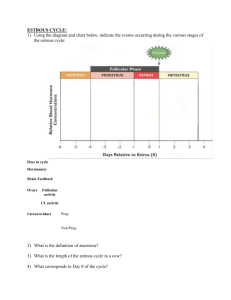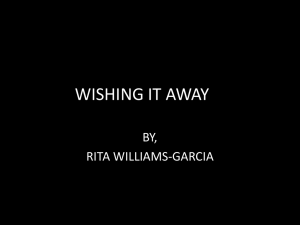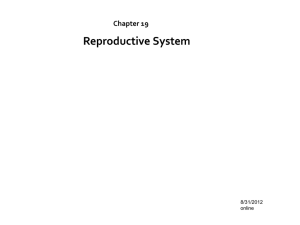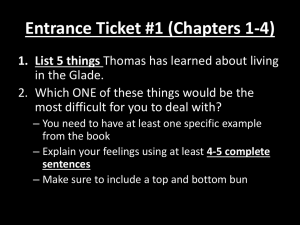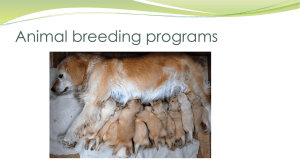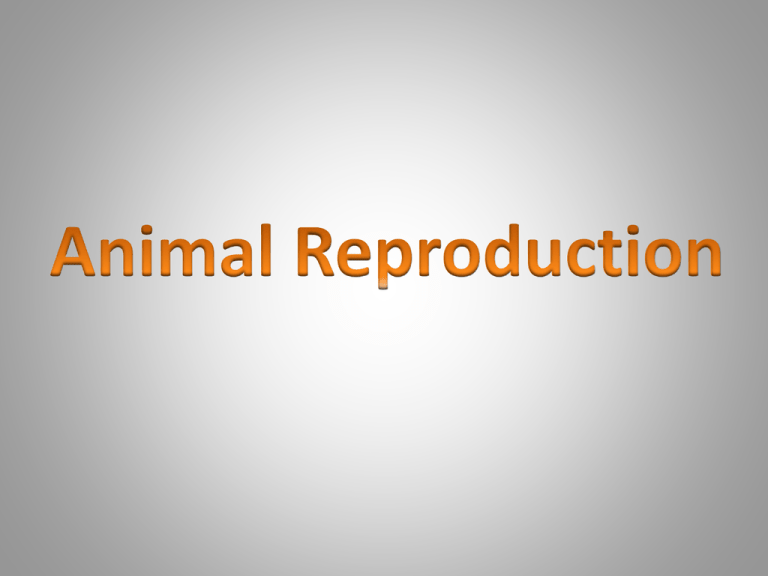
Female Vocabulary
• Ovary- female gonad that produces ova (eggs),
and hormones estrogen and progesterone
• Oviduct-(Fallopian tube) tube that extends from
ovary to uterus. Carries ova to uterus. Not
attached to ovary.
• Uterus- hollow organ with thick, muscular walls
and mucus lining. Houses developing embryo
during pregnancy. Embryo attaches to uterine
wall. Sits on top of bladder and below rectum.
• Cervix- between uterus and vagina, consists of
think ring-like muscles called sphincters.
Prevents foreign substances from entering
uterus. Normally closed except during estrus.
• Vagina- extends from cervix to outside the
body. Serves as passage for semen into body,
and offspring out of the body.
• Vulva- female external genetalia. External
opening to urogenital tract.
Estrous Cycle
• Follicular Phase
– Proestrus- period when follicles (ova/eggs) grow.
Uterine lining develops, animal not sexually
receptive yet. Depending on species, could last 3
weeks or 1 day
– Estrus- short length of time (couple hours to just 1
or 2 days), period of sexual receptivity. Ovulation
occurs. Large production of estrogen
• Ovulation- ovary releases ova/egg into oviduct
Estrous Cycle, cont’d
• Luteal Phase
– Metestrous- Estrogen subsides, Corpus Luteum
develops. Uterus produces small amounts of hormone
Progesterone. Lasts 1-5 days
– Diestrous- Corpus Luteum produces large quantities of
Progesterone (if pregnant). When Corpus Luteum
regresses, diestrous ends, proestrous begins again.
Lasts up to a number of weeks.
• Anestrus – period of time when animal does not
experience estrous cycle. This could be due to
season (in seasonally polyestrous animals),
pregnancy, lactation, illness, or age
Estrous Cycles
• Polyestrous- animals that have more than one
estrous cycle per year. Ex: cats, cows, pigs,
horses
– Seasonally Polyestrous- animals that have estrous
cycles in a specific time of year
• Long day breeders (spring): horses, hamsters
• Short day breeders (fall): sheep, goats, deer
– Diestrous- animals that have estrous cycles twice a
year: Dogs
• Monestrous- animals that have only one
estrous cycle per year.
– Ex: bears, foxes, wolves
• Induced ovulators- animals in which ovum
(eggs) are only released after copulation
(mating)
– Ex: cats, rabbits, llamas, ferrets
Gestation Lengths
•
•
•
•
•
•
•
•
•
Dog (Bitch)- 63 days
Cat (Queen)- 63 days
Rabbit (Doe)- 31 days
Horse (Mare)- 340 days
Cow (Cow)- 285 days
Pig (Sow)- 114 days (3 months, 3 weeks, 3 days)
Sheep (Ewe)- 147 days
Goat (Doe)- 150 days
Chicken (Hen)- 21 days
Uterine Bodies
• Simplex- no uterine horns. Primates (humans)
• Duplex- Large horns, no uterine body, 2
cervices (cervix). Rodents and lagomorphs
(rabbits, hares)
• Bicornuate- has both uterine horns and
uterine body. Pigs, cow, mare, sheep
Sheep
Stages of Prenatal Growth
• Fertilization- when sperm and egg (ova) unite
• Attachment- when the embryo attaches itself to the
uterus for further development
– Types of placenta
•
•
•
•
Diffuse- horse, pig
Cotyledon- cow, sheep etc.
Zonary- dogs, cats, bears, elephants
Discoidal- primates, rodents
• Embryonic Stage- Period when body parts and organs
start to form
• Fetal Stage- Period when body parts and organs
mature. Lasts until birth
Bulbourethral
Gland
Male Vocabulary
• Scrotum- external sac that houses and protects
testicles. Keeps testicles at temp slightly lower
than the body.
• Testicles- Male sex glands that produce sperm
and hormone testosterone
• Epididymis- Where sperm are store to mature
• Vas deferens- (ductus deferens)- transports
sperm from epididymis to urethra
• Urethra- tube passing through penis to outside of
body, transporting urine and semen.
• Accessory Sex Glands- Provide fluids to semen
which provide health and nutrition to sperm
– Seminal Vesicles, Prostate Gland, Bulbourethral
glands
• Penis- Male sex organ, carries semen and
urine out of body. Made of erectile tissue that
fills with blood upon stimulation, this causes
erection.
AI vs. Natural Cover vs. In-vitro
• Artificial Insemination- semen is ‘collected’ from the male
(sire/stud) and manually depositing into female
– Pros- can breed more females in a short time, better genetic selection
– Cons- expensive, requires specialized training, costs time and labor
• Natural Cover- actual physical mating of a male and female of a
species
– Pros- cheaper, less time required by owner
– Cons- dangerous to stud, limited to local/cheap studs
• In-vitro- process in which egg/ova is fertilized outside the uterus (ie
test tube/culture dish
– Pros- can utilize genes of superior female that cannot reproduce (not
so much cows
– Cons- very expensive
Dystocia
• Definition- difficult birth
• During birth, when the
baby (calf, lamb, foal)
presents itself in the
wrong position
• Correct position- front
hooves first, then nose,
then rest of body.
• Twinning- Multiples are very common in
sheep, and sometimes occur in cattle. Rare in
horses and twin foals don’t always survive.
• Freemartinism- sexual abnormality in cattle.
Causes infertility in a female calf born with a
male twin. Female demonstrates male
behavior and has non-functioning ovaries
– Occasionally occurs in pigs, sheep, goats
Autosomes- chromosomes that determine traits
other than gender
Sex Chromosomes- 1 pair of chromosomes that
determine gender
X Chromosome- Female (XX)
Y Chromosome- Male (XY)
Half of total chromosomes come from father, half
come from mother
Phenotype- outwardly displayed trait
Genotype- genetic code of a specific trait
2 types of traits: Dominant and Recessive
Dominant genes will ALWAYS be displayed
Recessive genes will only be displayed if there is no dominant
gene present
Homozygous Dominant- BB
Homozygous Recessive- bb- recessive is shown
Heterozygous- Bb – Dominant is shown
Punnett Squares
Parent 1’s Chromosomes of
specific trait
Parent 2’s
Chromosomes
of specific
trait
B
B
B
BB
BB
B
BB
BB
Homozygous Dominant
B
B
B
BB
BB
B
BB
BB
100 % of offspring will show dominant trait
Homozygous Recessive
b
b
b
bb
bb
b
bb
bb
100% of offspring will show recessive trait
Heterozygous
B
b
B
BB
Bb
b
Bb
bb
25% of offspring will beHomozygous Dominant (BB)
25% of offspring will be Homozygous Recessive (bb)
50% of offspring will be Heterozygous
(Bb)
75% will show Dominant trait
25% will show Recessive Trait
On your own….

